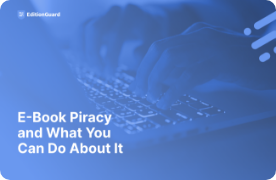Trade secrets and other intellectual property (IP) are critical to a company’s success. Protecting IP can be challenging, especially in an increasingly digital age. While there are numerous legal mechanisms and regulations to protect IP, digital piracy remains a pressing issue. Digital Rights Management (DRM) software is a very effective tool to protect digital media such as novels, textbooks, and other works. This post examines ways to protect digital IP and how DRM solutions can aid those efforts.
(Source: Adobe)
What Are Trade Secret/Intellectual Property Laws?
We can define “trade secrets” very broadly. A trade secret is any confidential or proprietary business information that can provide a competitive advantage. That might be a chemical formula, a manufacturing process, sales methods, advertising strategies, and so on. Unauthorized access to and use of this information is considered a violation of trade secrets and may be deemed unfair competition. Trade secrets are protected by Intellectual Property laws, which serve to incentivize inventors and protect their intellectual property from infringement or theft. If intellectual property is infringed upon or stolen, the owner of that intellectual property can file a lawsuit in federal court. There are a number of remedies if the lawsuit is successful. The court may issue an injunction to prevent further infringement and can issue substantial fines and impose damages to recover lost revenue and deter further infringement.(Source: Adobe)
How Do Those Laws Differ From Patents, Copyrights, And Other Content Protections?
Intellectual property laws are one way to protect creative works, but there are other terms we should consider: patents, copyrights, and trademarks. Let’s examine each of these in more detail: Patents: A right granted by the government that excludes others from making, using, or selling an invention. Patents are valid for 20 years from the date approved by the U.S. Patent and Trademark Office (USPTO). The USPTO issues patents for “any new and useful process, machine, manufacture, or composition of matter, or any new and useful improvement thereof.” Copyrights: A form of intellectual property protection available for original works of authorship. Those works can include literary works, paintings, software, films, and live performances. A copyright grants the owner the exclusive right to publish, reproduce, perform, or distribute that creative work. Copyrights typically last as long as the lifetime of the owner, plus 70 years. The owner can permanently or temporarily transfer ownership to other parties. To ensure full protection, copyrights should be registered with the U.S. Copyright Office. Trademarks: A trademark can be a word, phrase, symbol, or design identifying the origin of the goods of one party relative to other parties. Some examples include logos, brand names, and slogans. Unlike patents or copyrights, trademarks do not expire after a set number of years. A similar concept is a Service Mark, which applies to services rather than goods. In theory, a trademark can last forever as long as the owner continues to use it in the marketplace. In addition, trademarks don’t even need to be registered, though there are benefits to doing so. Registering a trademark with the USPTO notifies the public of the registrant’s claim to the trademark and creates a legal presumption of nationwide ownership.(Source: Adobe)
Legal Protections For Trade Secrets
There are also a number of legal mechanisms to protect trade secrets. The most common are non-disclosure agreements and non-compete agreements. The differences between these two legal mechanisms are examined below: Non-Disclosure Agreements (NDA): An NDA is a legally enforceable contract that creates a confidential relationship between two parties—the party that possesses a trade secret, and the party to whom that secret is disclosed. NDA’s protect sensitive information and can protect patent rights, as public disclosure of an invention can void those rights. A broad range of information can be covered under an NDA, such as customer lists, R&D results, and other sensitive data. An effective NDA includes definitions of confidential information, obligations from involved parties, and the time period in which the NDA is in effect. Non-Compete Clauses (NCC): A contract between an employer and an employee, where the employee agrees not to enter into competition with the employer after being terminated. An NCC typically prevents that employee from entering into markets where the employer competes or joining direct competitors. Employers use NCC’s for a variety of reasons. NCC’s prevent employees from revealing confidential information to competitors, who would be particularly positioned to exploit that information. Specific information is necessary for an NCC to be binding: an effective date, purpose of the agreement, key definitions (duration and type of work), and compensation. The terms and duration of NCC’s can vary, and some states may not even enforce these contracts.What is DRM And How Does it Work?
DRM, or Digital Rights Management, involves various methods of protecting digital files from piracy, theft, or unauthorized access. In the publishing industry, DRM protection for e-books normally takes the form of password, watermark, and encryption-based solutions in order to protect against piracy. The level of e-book protection a publisher needs depends on the type of document being published, the intended audience, and the specific distribution channel. There are a number of specialized tools such as Adobe DRM that provide greater protection. Here are three of the most commonly used DRM solutions:Password Protection
We can use a number of applications such as Adobe Acrobat or Preview (the Mac alternative) to password-protect PDFs and e-publications. However, these solutions offer no flexibility in terms of what users can access; they either have the password to access the whole file, or they don’t. This solution can deter unauthorized access, but the encryption is less than industry standard. Acrobat or Preview encryption can be easily removed, often for free, using different online software tools. In addition, a more sophisticated hacker can use a brute force attack, which involves testing thousands of password combinations until the password is discovered. A cell phone or other electronic device may have safeguards to prevent or slow this kind of penetration attempt, but publishing applications typically are less sophisticated.Watermarking Or “Social DRM”
Social DRM can take many forms but typically involves imprinting files with a visible (or maybe invisible) watermark containing the reader’s personal information. Digital watermarking for e-books discourages unauthorized sharing, as a file containing the reader’s name or other information can be easily tracked and attributed.Industry-Standard DRM Protection
Industry-Standard DRM protection offers secure encryption and the flexibility to control what users can and cannot do with our PDFs and e-publications. These security solutions need to be continuously updated and refined in order to provide the highest level of protection. Hackers and other actors are always trying to devise new ways to beat our encryption, which is why we need to work just as hard to stay one step ahead. Adobe DRM solutions are updated constantly to provide the best possible protection for e-books and other digital publications.(Source: Adobe)






